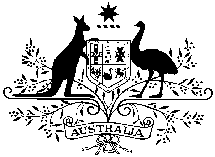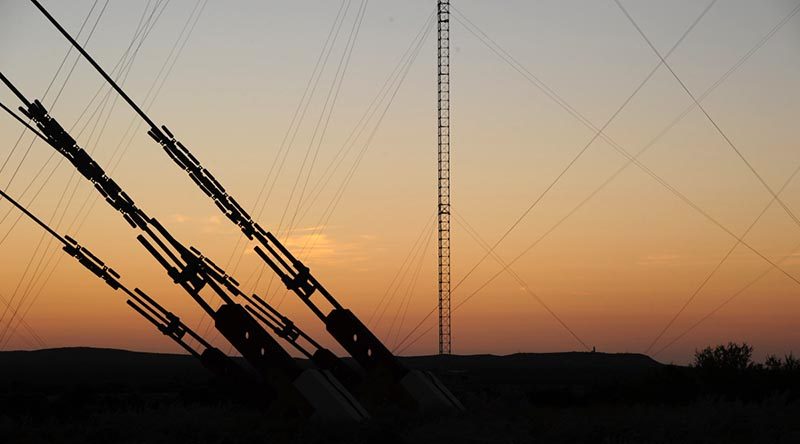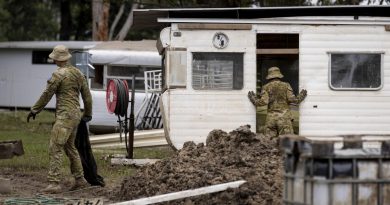Ministerial Statement – [secret] joint facilities
Share the post "Ministerial Statement – [secret] joint facilities"


Statement by the Minister for Defence,
the Hon. Christopher Pyne, MP.
Joint Facilities: Enhancing Australia’s Security and Prosperity
20-02-2019
Introduction
The joint facilities we operate with the United States, such as the Joint Defence Facility Pine Gap, as well as the Australian facilities that host
US strategic capabilities, are some of the most tangible manifestations of
the strength and depth of the Australia-United States Alliance.
However, due to the classified nature of some of the most sensitive work performed at these facilities, it is necessary that relatively few people are briefed on those roles and functions.
It is therefore in the public interest that Governments make periodic public statements on these facilities.
Today, I want to update the Parliament and the Australian public on the deliberate policy principles that govern these facilities and the contributions they make, not only to regional and global security, but to our own security and national prosperity.
The public can have confidence that its Government is acting lawfully and responsibly in overseeing such activities, and that Australia’s continuing support for these activities is in our nation’s best interests.
The Australia-United States Alliance – underpinning Australian security
The United States is our most important ally. Our military forces work side-by-side around the world, to meet global security challenges and to promote peace and stability in the Indo-Pacific region.
No other global power has values and interests more closely aligned with Australia’s than the United States.
The presence of US military forces across the Indo-Pacific plays a vital role in ensuring regional security, and the strategic and economic weight of the US is essential to the continued effective functioning of the rules-based global order.
Australia’s alliance with the US is enshrined in the ANZUS Treaty, signed on 1 September 1951.
With the support of successive Australian and US Governments, the Alliance has grown in depth and complexity over time, and continues to deliver real benefits to both our countries.
The Alliance gives us unparalleled access to the most advanced technology, equipment and intelligence, which is central to maintaining the potency of the Australian Defence Force.
Australia sources much of our most critical combat capability from the US.
Australia would be unable to develop the range of high-end capabilities we need without the Alliance.
Crucially, the Alliance also means that Australia benefits from the extended nuclear deterrence provided by the US.
During the Cold War, the US contributed to the security of its allies through its ability to respond with nuclear weapons if allies were attacked by the Soviet Union.
Today, global geopolitics have changed, but the core principles of extended nuclear deterrence have not.
Potential adversaries understand that an attack on Australia is an attack on the Alliance.
This brings me to an important point.
Australia is not only a beneficiary of the US policy of extended nuclear deterrence, it is an active supporter of it, through our joint efforts with the US at Pine Gap and at other facilities, such as the Naval Communications Station Harold E. Holt, and the Joint Geological and Geophysical Research Station.
As the then-Prime Minister, Bob Hawke, noted in his public statement on Pine Gap in 1984, Australia should not claim the protection of nuclear deterrence without being willing to make a contribution to its effectiveness.
Hosting these joint facilities and US strategic capabilities on our soil is Australia’s important contribution to the Alliance.
The Joint Defence Facility Pine Gap – over fifty years of success
The Joint Defence Facility Pine Gap has made – and continues to make
– a critical contribution to the security of both Australia and the US.
It represents one of the finest examples of collaboration, innovation and integration, and has delivered remarkable intelligence dividends to both
our nations.
As its name clearly states, Pine Gap is a ‘joint’ defence facility, run by the governments of both Australia and the US – as close and enduring partners.
Pine Gap’s workforce is split approximately 50:50, between Australians and Americans, with Australians holding key decision-making positions at the facility and having direct involvement in operations and tasking.
Since its establishment in 1967, Pine Gap has evolved from its original Cold War mission, focused on early warning for Soviet ballistic missiles, to meet new demands and new challenges.
It has acquired cutting-edge, innovative technologies to do so.
Pine Gap has become a central element of our intelligence cooperation with the US and it continues to have relevance in delivering intelligence on a range of contemporary security priorities, such as terrorism, the proliferation of weapons of mass destruction and monitoring foreign weapons development.
Pine Gap also supports compliance monitoring with international arms control and disarmament agreements.
By hosting this capability, Australia supports the verification of adherence to arms control agreements, in keeping with the Government’s comprehensive policy approach to arms control and counter-proliferation.
It has provided monitoring and early warning capabilities of ballistic missile launches since 1999, following the closure of Joint Defence Facility Nurrungar.
Reliable, early and accurate warning of ballistic missile launches provides a crucial contribution to global stability, with Pine Gap helping to provide reassurance against the possibility of a surprise missile attack.
Much has been theorised about Pine Gap’s role, for instance its contribution to US operations against terrorism.
While the Australian Government, as a matter of longstanding practice, does not comment on intelligence matters, Australians can be assured that the Government has full oversight of activities undertaken at Pine Gap and that these activities are undertaken in accordance with Australian and international law.
The significant value of Australian facilities supporting United States capabilities
While Pine Gap may be the highest profile joint facility on Australian soil,
it is not the only facility in Australia that is jointly operated with the US,
or that hosts US defence activities and capabilities.
The Joint Geological and Geophysical Research Station is another joint facility that Australia operates with the US in Alice Springs.
This facility, run by Geoscience Australia and the US Air Force, was established in 1955 to monitor nuclear explosions during the Cold War.
Today, it performs a crucial role as part of the International Monitoring System of the Comprehensive Test Ban Treaty, which prohibits “any nuclear weapon test explosion” anywhere in the world.
It is a little-known fact that this Research Station, in Alice Springs, detected and geo-located North Korea’s sixth nuclear test, on 3 September 2017.
Like Pine Gap, the Naval Communication Station Harold E. Holt,
in Exmouth, Western Australia, has also contributed to Australia’s national security for over half a century.
This Australian facility, which was previously jointly operated with the US Navy until we assumed full control in the 1990s, provides communications for Australian and US submarines and ships.
This includes communications for the submarine-based nuclear deterrence capabilities of the US in the Indo-Pacific, which are crucial to credible deterrence, a stable nuclear balance and our own security.
Another important communications facility is the Australian Defence Satellite Communication Station in Geraldton, Western Australia, which hosts a ground station for US military satellite communications systems used by Australian and US forces on operations.
This facility contributes to the safety of deployed Australian and US military personnel.
More than military and intelligence value
While much of the public debate seems to centre on the military applications of US capabilities in Australia or their contributions to intelligence matters, these capabilities also play a crucial role in our everyday lives.
In 2017, a new space surveillance radar reached full operational capability at the Harold E. Holt facility.
This radar serves as a dedicated sensor node in the Global Space Surveillance Network, in support of our Combined Space Operations cooperation with the US, United Kingdom, Canada and New Zealand.
It will be joined by a new space surveillance telescope, which is scheduled to reach full operational capability in 2022.
Together, this radar and telescope will identify and track objects in space, which will help satellite owners avoid collisions with space junk and other satellites.
With so many aspects of Australian life and business reliant on satellites,
if one were to be severely damaged or knocked out of orbit, that could have disastrous impacts on Australian individuals and businesses.
As another example, the Learmonth Solar Observatory, also in Western Australia, monitors solar emissions, which helps to protect communications equipment from solar interference.
This space weather facility is jointly operated by the Bureau of Meteorology and the US Air Force.
Solar weather can affect transmission quality for services, such as mobile phone and internet networks as well as television and radio transmissions.
Solar weather can also affect power grids, causing blackouts.
Predicting solar weather is important because it allows organisations that own infrastructure, such as satellites, communication networks or power grids, to mitigate its impacts.
This is particularly relevant as more people use wireless internet devices as part of their daily lives, whether that be for entertainment, education, social media or business.
Our work with the US has also allowed us to share critical information.
As a result, the intelligence we produce together has saved lives.
It has saved American and Australian lives, not only on the battlefield, but it has saved civilian lives as well.
Protecting and enhancing our economic wellbeing
As outlined in the 2016 Defence White Paper, defending our maritime trade routes is part of Australia’s primary strategic defence priorities.
These maritime highways are the backbone of our foreign trade coming in and out of Australia. It is crucial for Australian jobs and our economy that these routes remain open and secure, with unimpeded freedom of access.
Regional actions have the ability to adversely impact regional security and economic stability.
Facilities such as Pine Gap help reduce this risk, in support of the rules based global order, by providing early warning of potentially hostile activities and developments that threaten to destabilise the region.
It is also important to recognise the real economic and social benefits these facilities have in regional Australia.
Apart from the jobs generated directly by these facilities, workers contribute to local economies and form part of the social fabric of these communities.
Full Knowledge and Concurrence – protecting Australia’s sovereignty
While successive Australian Governments have recognised the national security benefits that we gain from the joint facilities and by hosting US capabilities, they have also recognised that our national interests and sovereignty have to be honoured and protected.
This has been achieved by our policy of full knowledge and concurrence.
Full knowledge and concurrence is central to Australia hosting any foreign capability, be they from the US or any other country.
It is an expression of Australia’s sovereignty and a fundamental right to know what activities foreign governments conduct on our soil.
‘Full knowledge’ equates to Australia having a full and detailed understanding of any capability or activity with a presence on Australian territory or making use of Australian assets.
‘Concurrence’ means that Australia approves the presence of a capability or function in Australia, in support of mutually-agreed goals.
That does not mean Australia approves each and every activity or tasking undertaken; rather, it means that Australia agrees to the purpose of activities conducted in Australia and also understands the outcomes of those activities.
But I can assure the Parliament and the Australian public, we maintain appropriate levels of oversight for the activities undertaken.
Importantly, concurrence also means that Australia can withdraw agreement if the Government considers that necessary.
At a practical level, full knowledge and concurrence means:
First, that Australia is to be consulted about any new purpose proposed for any activity, or a significant change to an existing purpose, and we will be advised of any significant change to expected outcomes.
Second, it means that Australia will be briefed and advised on outcomes actually achieved.
And finally, proposals for new equipment or significant upgrades to existing equipment, including communications links, will be advised in sufficient time to confirm that the changes align with mutually-agreed purposes, or to seek further clarification, if required.
There is much work undertaken to ensure that the objectives of these practical steps are met.
The Department of Defence regularly reviews the management and implementation of this policy to ensure – and be fully satisfied – that governance is effective and being appropriately and stringently
adhered to.
Australians who hold senior positions at these joint facilities, as well as at Australian facilities that are used by foreign governments, are fully and deeply integrated into decision-making and implementation processes.
While the details of the policy and its implementation have evolved over time, to better reflect the changes in our national security environment and to keep pace with technological progress, the fundamental principles of full knowledge and concurrence have not changed, and we are never complacent about its application.
Conclusion
It is in both nations’ interests to have a secure and stable region, and the joint facilities and capabilities all play their role in ensuring regional security and stability is achieved.
But the Alliance and regional stability cannot be taken for granted.
This Government remains committed to growing and deepening all aspects of the relationship and working with the US to advance our mutual defence and security interests.
Our defence and intelligence cooperation will continue to evolve to meet ever-changing threats and challenges. As it must.
The spirit of innovation shared by our nations will continue to support the Australia-US Alliance and continue to be our strength, as the Alliance evolves now and into the future.
As we adapt to meet new challenges to the rules based global order, our defence and intelligence cooperation and joint facilities will endure as our ever vigilant eyes and ears in the world.
Thank you.
Authorised by Christopher Pyne, Minister for Defence, SA, Australia.
.
.
.
.
.
.

.
.
Share the post "Ministerial Statement – [secret] joint facilities"





